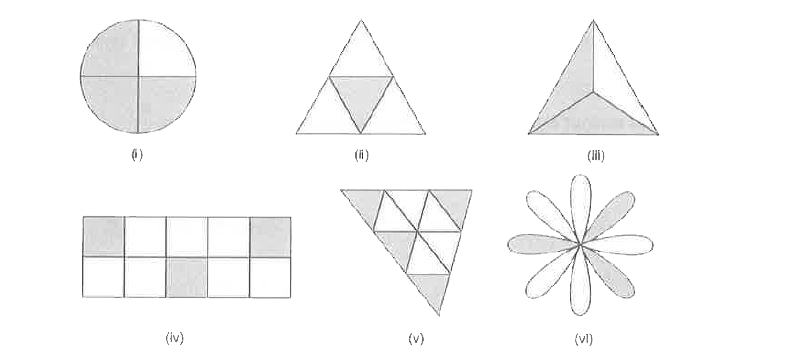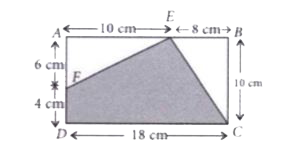Write the fraction representing the shaded portion.
To find the fraction representing the shaded portion in each figure, we will follow these steps:
Step 1: Identify the Total Parts
For each figure, we first need to determine how many total parts the shape is divided into.
Hint: Count all the equal sections in the shape.
Step 2: Count the Shaded Parts
Next, we will count how many of those parts are shaded.
Hint: Carefully count only the parts that are shaded.
Step 3: Write the Fraction
Now, we can write the fraction representing the shaded portion. The fraction is written as the number of shaded parts over the total number of parts.
Hint: The format for the fraction is: (number of shaded parts) / (total parts).
Step 4: Simplify the Fraction (if necessary)
If possible, simplify the fraction to its lowest terms.
Hint: Look for common factors in the numerator and denominator.
Example Solution:
1. Triangle Figure:
- Total parts: 4
- Shaded parts: 2
- Fraction: 2/4 (which simplifies to 1/2)
2. Rectangle Figure:
- Total parts: 9
- Shaded parts: 8
- Fraction: 8/9 (already in simplest form)
3. Balls:
- Total parts: 8
- Shaded parts: 4
- Fraction: 4/8 (which simplifies to 1/2)
4. Circle:
- Total parts: 4
- Shaded parts: 1
- Fraction: 1/4 (already in simplest form)
5. Blocks:
- Total parts: 7
- Shaded parts: 3
- Fraction: 3/7 (already in simplest form)
6. Flowers:
- Total parts: 12
- Shaded parts: 9
- Fraction: 9/12 (which simplifies to 3/4)
7. Figure with 10 parts:
- Total parts: 10
- Shaded parts: 10
- Fraction: 10/10 (which simplifies to 1)
8. Another Triangle:
- Total parts: 9
- Shaded parts: 4
- Fraction: 4/9 (already in simplest form)
9. Flower with Petals:
- Total parts: 8
- Shaded parts: 4
- Fraction: 4/8 (which simplifies to 1/2)
10. Insect:
- Total parts: 2
- Shaded parts: 1
- Fraction: 1/2 (already in simplest form)
Final Note:
Each fraction represents the proportion of the shaded area in relation to the whole shape.
For each figure, we first need to determine how many total parts the shape is divided into.
Next, we will count how many of those parts are shaded.
Now, we can write the fraction representing the shaded portion. The fraction is written as the number of shaded parts over the total number of parts.
If possible, simplify the fraction to its lowest terms.
1. Triangle Figure:
- Total parts: 4
- Shaded parts: 2
- Fraction: 2/4 (which simplifies to 1/2)
- Total parts: 9
- Shaded parts: 8
- Fraction: 8/9 (already in simplest form)
- Total parts: 8
- Shaded parts: 4
- Fraction: 4/8 (which simplifies to 1/2)
- Total parts: 4
- Shaded parts: 1
- Fraction: 1/4 (already in simplest form)
- Total parts: 7
- Shaded parts: 3
- Fraction: 3/7 (already in simplest form)
- Total parts: 12
- Shaded parts: 9
- Fraction: 9/12 (which simplifies to 3/4)
- Total parts: 10
- Shaded parts: 10
- Fraction: 10/10 (which simplifies to 1)
- Total parts: 9
- Shaded parts: 4
- Fraction: 4/9 (already in simplest form)
- Total parts: 8
- Shaded parts: 4
- Fraction: 4/8 (which simplifies to 1/2)
- Total parts: 2
- Shaded parts: 1
- Fraction: 1/2 (already in simplest form)
Each fraction represents the proportion of the shaded area in relation to the whole shape.
Topper's Solved these Questions
Similar Questions
Knowledge Check
The fraction representing the blank portion in the given figure is
 A12 Proper FractionB23 Proper FractionC13 Proper FractionD13 Improper Fraction
A12 Proper FractionB23 Proper FractionC13 Proper FractionD13 Improper Fraction
The fraction represented by the shaded portion in the adjoining figure is 38
View SolutionThe fraction represented by the unshaded portion in the adjoining figure is 59
View SolutionWrite the fraction representing the total number of natural numbers in the collection of numbers -3, -2, -1, 0, 1, 2, 3. What fraction will it be for whole numbers?
View Solution(i) Write the fraction of the shaded portion:

View SolutionFind the area of the shaded portion.

View SolutionState the decimal represented by the shaded parts in the following figures.

View SolutionFind the area of shaded portion.
View Solution


